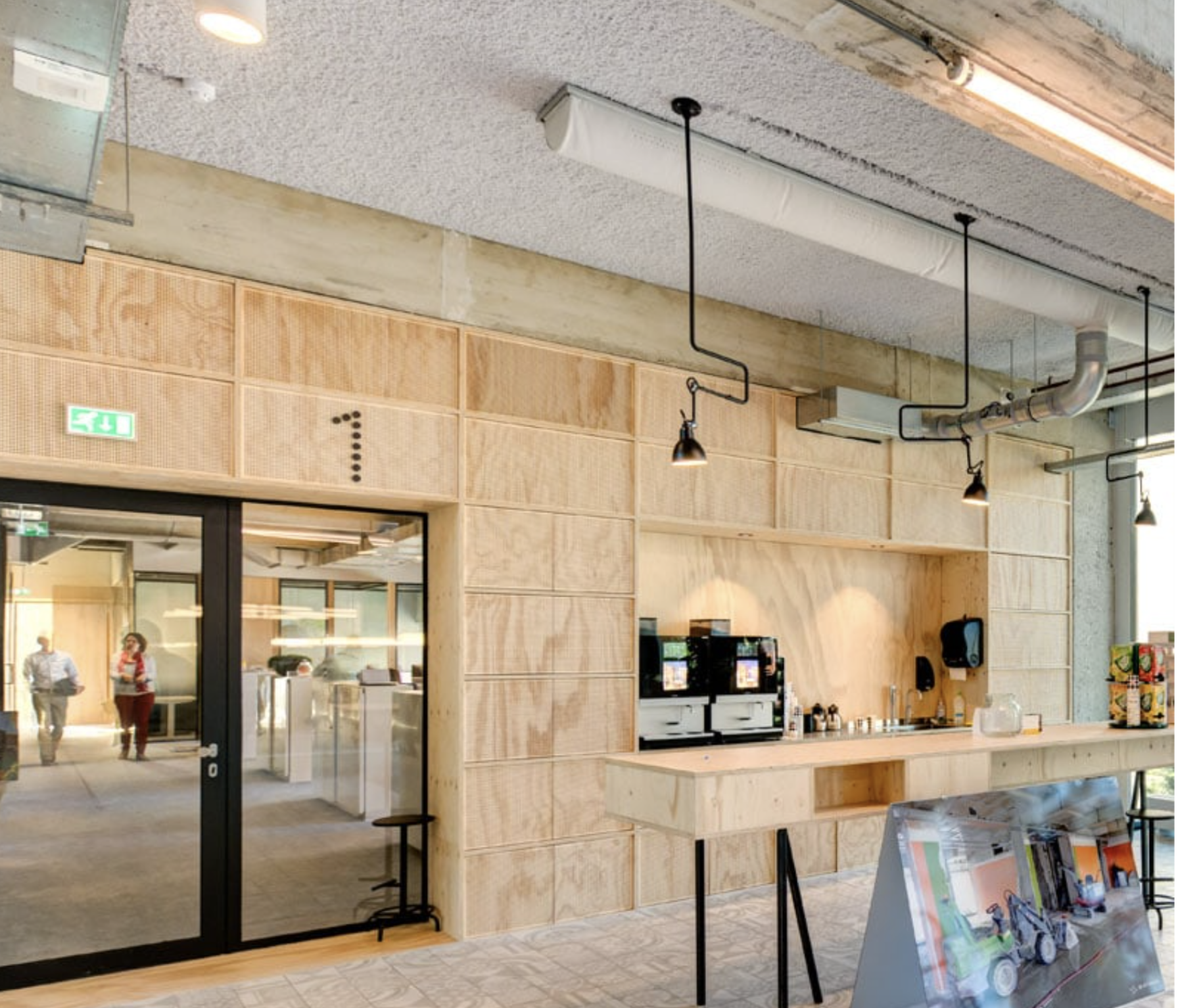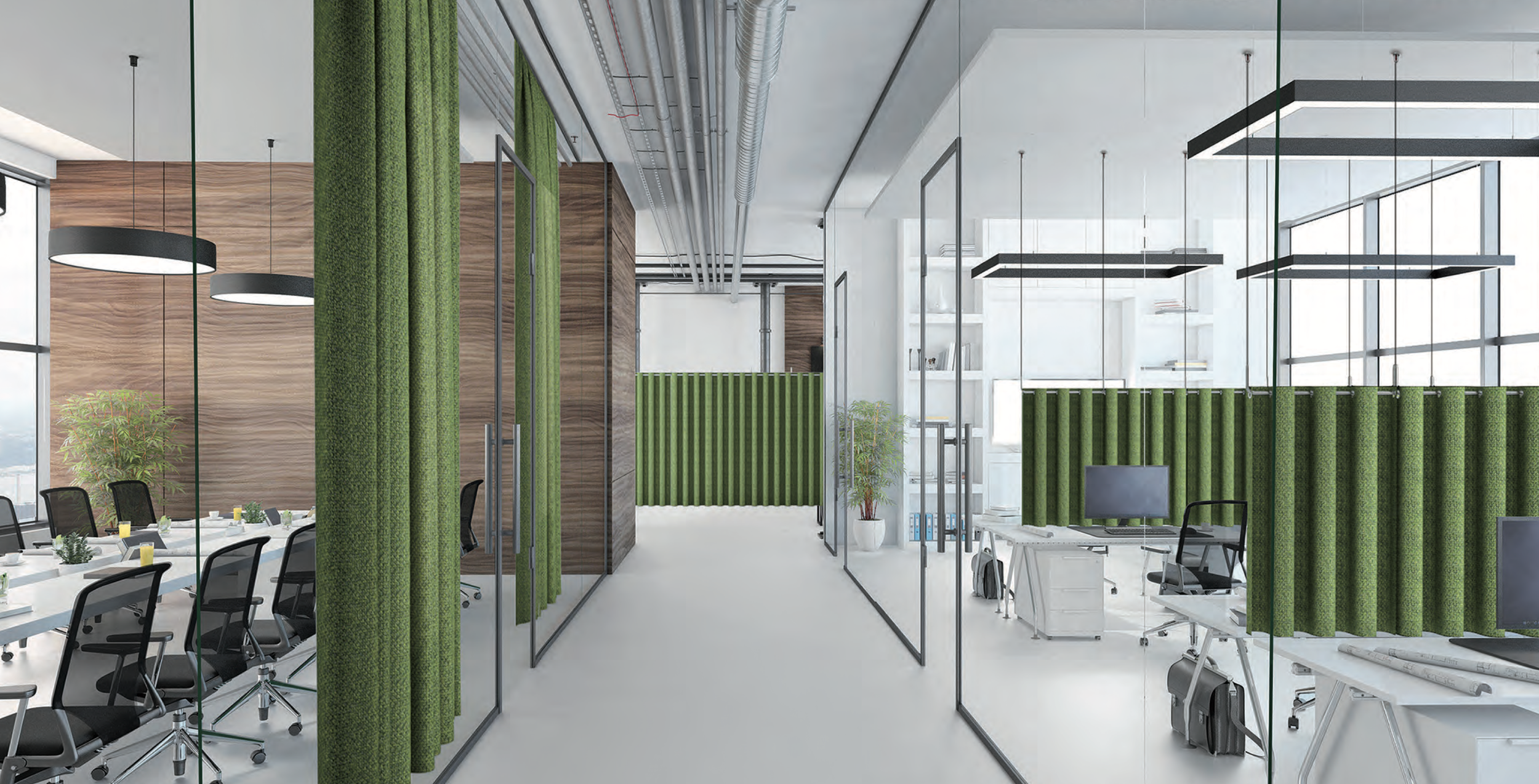Sound panels and acoustical treatments are often one of the last items to be considered on a project but they can also be a design feature if you incorporate them with intention.
Flat, smooth, hard surfaces all reflect sound. Adding soft, absorptive, multifaceted, and porous elements can help absorb and disperse sound waves. Here are a few ways to add acoustic treatments to help your space sound as good as it looks! We’ll start from some of the most basic and work our way down to more intricate ones….
Some of the most “traditional” and affordable acoustic treatments are the rigid tackable wall mounted sound panels. They are often produced in nominal material sizes — the 4x8 being the most economical. These are most commonly used in performance spaces and rooms with a high volume. A company like Benton Brothers is a great resource for these.
Wall tacked acoustic panels in the Athens Church auditorium
I don’t know why— but I think these panels look significantly better when they are pushed together. Perhaps it’s me just trying to break away from the 4x8 module, but I think playing around with the spacing even if you can’t change the size can add some design to the room. The panels can be made in almost any size / shape, however the cost is significantly greater for the labor if you break away from the 4x8 size.
These can come wrapped in a myriad of fabrics, but the most commonly used (and affordable) is the Guilford of Maine FR 701- 2100 series You can order samples and color cards on their site. If you are using sound panels to cover a significant portion of wall, it is likely that you will need to cover them with a fire rated fabric. Always check with local fire and building codes when covering walls with a fabric to make sure it meets safety standards for your space.
With panels that are wall mounted and wrapped in fabric, I recommend installing them so that the bottom is no lower than 5’ off of the ground. This will help the panel last as long as possible — keeping it above handprints, chair backs, and young children.
This image is taken from the Guilford of Maine website - representing the array of colors in the acoustic panel fabric line FR-701.
If you are considering adding wall panels to a performance space, I would consult with an AVL company (audio/ video/ lighting) to discuss how the wall panels can impact the audio of your space. If you are looking for an AVL company Clark is a great one!
Looking to add walls panels in a smaller application like a meeting room or office? Check out companies like Turf - they offer a myriad of shapes and colors to cover walls and ceilings.
Adding treatments over head can also be a great way to absorb sound. A common treatment is lapendary - an apsorbative treatment tacked directly to an open ceiling. This treatment can really help — and be affordable in cost per sq ft — but it does have a “plastic bag”-like appearance, so I would not recommend it on especially low ceilings or ones that get a lot of sunlight. This treatment is great for large areas with very high open ceilings. Ceilings with a lot of metal truss and pipes are helpful to hide the look too :) If it is within the means of your project, I HIGHLY recommend reaching out to a professional like Benton Brothers to assess your needs. It is much better than guessing :-) and they have so many resources for you!
Acoustic lapendary tacked to the open ceiling between trusses
You have probably been in a lot of spaces with a sprayed insulation. It has a bit of a fuzzy appearance. This can be done as a fire barrier in some applications but also can have a significant acoustical impact on the space helping diffuse and absorb a great deal of sound in the ceiling. Consult with your architect or contractor to see what type of spray insulation might be right for your space. Again - this one can help a lot but isn’t always the prettiest up close — so I’d recommend on taller ceilings. Treatments like lapendary and insulation are going to be more cost effective per sq ft than more decorative baffles and suspended features.
This image is taken from the Spray On site showing the K-13 Sound Absorption and thermal spray
The spray insulation in the ceiling helps with the acoustics in this open office space.
This image is taken from the Turf website - showcasing their suspended baffles
Baffles (shown above) are a name used for any suspended blade-like feature. Typically they hang with open space between each baffle. They can come in a variety of shapes and sizes — but they use the panel and the space in between each unit to deflect and trap sound. This takes your ceiling from a flat plane to a space with significantly greater surface area. If the blade is covered in a material like felt, that material helps absorb the sound even more.
Another way to add overhead treatments would be a more isolated design feature. A suspended trellis or beams can offer noise reduction over a meeting table or concentrated area. This feature offers a high aesthetic value but will not address larger noise concerns across a big room. The wood beams shown below are from Soundply
The wood beams are actually acoustic beams. They have a micro perforated surface to diffuse and absorb sound over the lobby table.
We used a felt trellis feature from Buzzi Space over the community table in this project to help absorb sound over the table.
The felt trellis shown helps absorb sound over the community table
Incorporating a material like felt can help with noise and can add a great texture to your space. I’d encourage you to use this in spaces where you are still able to access them to clean (because felt loves dust bunnies :). These are some felt trellis features that also incorporate light fixtures from Light Art.
This image is from the Light Art website showcasing their Acoustic Trellis
Adding curtain panels can help break up a space and add texture too. Curtains area. unique feature in that they can look great and still run the entire height of a space — offering acoustic support at every level of the space.
Snowsound fabric panels divide up an office to add privacy and cut down on noise
Fuller plusher fabrics (such as velvets) are used in theatrical spaces often because the texture (lots of surface area) is very effective with helping absorb sound. If you are looking for theatrical drape, GA Stage is a great resource.
All of the above treatments are applications that are added after a space is occupied. But the greatest consideration for the sound quality of your space can begin right from the start! If you are embarking on a renovation or new construction, talk with your architect about how you can shape the walls, ceilings, soffits, etc. to achieve your acoustic goals for the space. Consider the materials and surfaces to not only support the design aesthetic, but also support the function of the space. Incorporating texture into your materials from the start can offer a more discreet and well incorporated design rather than materials applied after the space is finished. Consider all surfaces - including the floors, walls, and ceilings. Surfaces with greater texture will provide more surface area to disperse sound — example: the bumpy, pitted texture of brick will help reduce echo more than a flat gypsum wall. The more texture your materials have and the more texture and variety there is in the architecture of the space, the more sound will naturally be broken up for you. The more like a flat box your room is… the more you create an echo chamber :)
If you are looking to add sound panels or acoustic treatments to your space, here are a few resources that can help











